Amazon and Industrial REITs: An Incredible Tailwind, But Future Looks Cloudy | May 2019
May 1, 2019
On February 15, 2019, shares of XPO Logistics (NYSE: XPO) fell 14% after the company announced that it was losing some contracts with Amazon (NASDAQ: AMZN). XPO is a third party logistics provider (or 3PL) that received $900 million in revenue from AMZN in 2018 for delivering packages to its customers. Because of AMZN’s decision to self-perform many of these deliveries, Wall Street analysts lowered their expectation for XPO’s revenue from AMZN by as much as 80%!
Industrial REITs should pay careful attention to the fate of XPO, as the company has already closed over 1 million square feet (or sqft) in the wake of the AMZN announcement. We estimate that the top ten industrial REITs derive 40% of their revenues on average from AMZN or 3PLs who count AMZN as a significant customer (Figure 1). While industrial landlords across the country can thank AMZN for helping increase rents and property values over the past ten years, we believe certain REIT share prices do not properly reflect the risk that the AMZN tailwind could go away someday or even become a headwind.

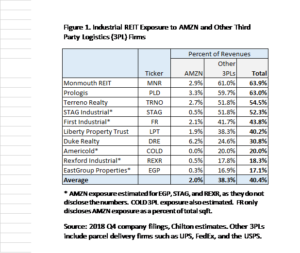
Amazon and Its 3PL Partners Dominate the Industrial Market
AMZN is famously secretive about its real estate, particularly with its warehouses and data centers. Using only the ‘easily available’ information from research firms, AMZN is occupying industrial space at a breakneck pace. However, we believe this data actually understates the actual space being occupied. Figure 2 shows our estimate of the actual square footage, which is nothing short of mind boggling. As far as we are aware, no private company has ever grown the real estate supporting its logistics infrastructure by more than 12 million sqft in a single year. Between 2014 and 2018, AMZN put up the five largest net absorption (new square footage leased or owner-occupied) numbers that the US industrial market had ever seen. Of note, the company absorbed 31.2 million sqft in 2016, which is 150% higher than the pre-AMZN record!

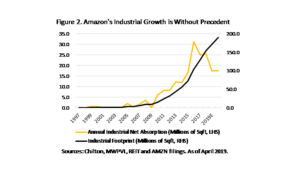
Even so, these staggering numbers likely underestimate AMZN’s true impact on the market. In spite of record net absorption, AMZN had actually been outsourcing even more! As shown in Figure 3, AMZN previously outsourced (white boxes) some of the ‘non-last mile’ portion of the supply chain, and almost the entire ‘last-mile’ portion.

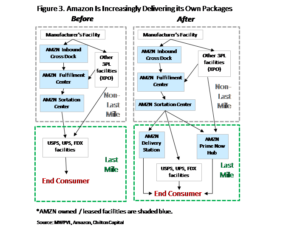
However, the company has recently been building out its own 3PL and delivery platforms (blue boxes). In fact, Morgan Stanley estimates that AMZN delivered 10-15% of its own packages at the end of 2018, which compares to less than 2% five years ago. As a result, while AMZN may be occupying more space, we believe it could come at the expense of space that was previously occupied by 3PLs and other third parties.
Big Diversified Industrial REITs Do Not Provide True Exposure to AMZN’s Growth
AMZN and e-commerce’s growth has benefited industrial landlords across the country. Investors have taken notice, bidding up industrial REITs to a far greater degree than office REITs or the REIT universe (see Figure 4).

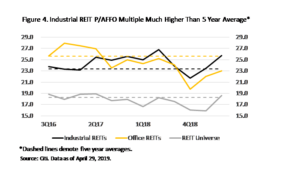
However, the rise in e-commerce does not benefit all real estate and REITs equally. First, as mentioned previously, AMZN builds out some of its own space, and is increasingly doing so. However, while it presently leases the vast majority of its space, only three REITs have meaningfully participated (see Figure 5). Of the 113 million sqft signed by the top 10 firms in Figure 5, 77% was done by private companies or non-REITs.

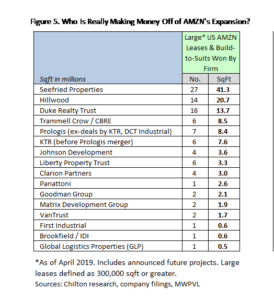
The truth is that industrial REITs have historically avoided the two types of properties that AMZN has been occupying: (1) high-tech, tenant-specific, suburban warehouses typically greater than 700,000 sqft, and (2) older, last mile, urban industrial flex properties typically smaller than 200,000 sqft. Going back to Figure 3, category (1) makes up most of the non-last mile, while category (2) makes up most of the last mile.
We estimate that no REIT derives more than 30% of its revenues from category (1), with the largest REITs all getting less than 10%. Rexford (NYSE: REXR) and Terreno (NYSE: TRNO) get over 80% of their revenues from category (2), but we do not believe there is another REIT that breaks 40%. Combined, TRNO and REXR comprised 0.7% of the MSCI US REIT Index, and only 8% of the market cap of the industrial REIT sector as of April 30, 2019. Therefore, the two companies that would stand to benefit from AMZN’s decision to grow its delivery/3PL platforms are actually only a small piece of the REIT investment universe.
Because the larger REITs such as Prologis (NYSE: PLD) and Duke (NYSE: DRE) currently have a higher exposure to AMZN and 3PLs, we believe that they could be disproportionately impacted if AMZN decided to build and/or own their own warehouses, as Walmart (NYSE: WMT) and Target (NYSE: TGT) have historically done.
PLD and DRE are trading at an average 7% premium to our estimated 2Q19 NAV as of April 30. TRNO and REXR trade at 12% and 2% premiums to NAV, respectively, as of the same date, despite the potential for much higher growth and lower development risks. TRNO and REXR trade at 35x and 32x 2020 consensus AFFO, which is higher than PLD (27x) and DRE (23x), but the latter two companies’ multiples are more at risk if AMZN’s growth slows.
For the few big box developments that REITs have actually built for AMZN, we remain cautious about their obsolescence risk if AMZN were to vacate at the end of the lease term. Historically, generic big box industrial warehouses were favored by institutional investors because they were easy to underwrite, had short construction and lease-up periods, required little operational oversight and maintenance capex, and could be easily and inexpensively re-leased to all types of tenants.
We cannot confidently say any of these things about the high-tech, specialized big box warehouses being built for tenants such as AMZN. Of the 76 big boxes greater than 700,000 sqft that AMZN has occupied or plans to occupy in the US between January 2016 and 2021, 73 were new builds. 22 are two-story properties with 850,000 sqft building footprints, 24 are single-story with mezzanine levels and 1 million sqft building footprints, and eight are three or four-story projects with 650,000 sqft building footprints. While some are optimistic about multi-story industrial warehouses, it is an unproven product in the US, which we believe carries higher re-leasing risk than single-story.
What Should Investors Do?
We recommend that investors ignore the ‘Amazon Effect’, and look deeper at underlying cash flow growth and long term risks. The vast majority of industrial REIT properties are second generation assets that AMZN would never even consider leasing today, not to mention in five or ten years. Some of the industrial REITs may be able to capture a development deal at an accretive spread occasionally from AMZN, but it won’t be significant enough to drive long term returns. In such cases, as we would advise for any highly specialized single tenant development, investors should be aware of the re-leasing risk that could require significant downtime, capital expenditures, and/or rent roll-downs. Similar to the pricing of such developments today, we believe the current risk versus reward ratio of the large industrial REITs is less attractive today.
Instead, we remain focused on a “last mile” company (REXR), an undervalued transformation story (Liberty Property Trust (NYSE: LPT)), and the niche category of temperature-controlled warehouses (Americold (NYSE: COLD)).
Parker Rhea, prhea@chiltonreit.com, (713) 243-3211
Matthew R. Werner, CFA, mwerner@chiltonreit.com, (713) 243-3234
Bruce G. Garrison, CFA, bgarrison@chiltonreit.com, (713) 243-3233
Blane T. Cheatham, bcheatham@chiltonreit.com, (713) 243-3266
RMS: 1909 (12.31.2018) vs 2000 (12.31.2017) vs. 346 (3.6.2009) and 1330 (2.7.2007)
Previous editions of the Chilton Capital REIT Outlook are available at www.chiltonreit.com/reit-outlook.html.
An investment cannot be made directly in an index. The funds consist of securities which vary significantly from those in the benchmark indexes listed above and performance calculation methods may not be entirely comparable. Accordingly, comparing results shown to those of such indexes may be of limited use.
The information contained herein should be considered to be current only as of the date indicated, and we do not undertake any obligation to update the information contained herein in light of later circumstances or events. This publication may contain forward looking statements and projections that are based on the current beliefs and assumptions of Chilton Capital Management and on information currently available that we believe to be reasonable, however, such statements necessarily involve risks, uncertainties and assumptions, and prospective investors may not put undue reliance on any of these statements. This communication is provided for informational purposes only and does not constitute an offer or a solicitation to buy, hold, or sell an interest in any Chilton investment or any other security.
for more info on our strategy
go now →
for more info on our strategy
go now →
VIEW CHILTON'S LATEST
Media Features
go now →
Contact Us
READ THE LATEST
REIT Outlook
go now →
disclaimers
terms & conditions & FORM ADV
SITE CREDIT
Navigate
HOME
TEAM
REITS 101
Approach
OUTLOOKS
media
Contact
back to top
VISIT CHILTON CAPITAL MANAGEMENT
This property and any marketing on the property are provided by Chilton Capital Management, LLC and their affiliates (together, "Chilton"). Investment advisory services are provided by Chilton, an investment adviser registered with the SEC. Please be aware that registration with the SEC does not in any way constitute an endorsement by the SEC of an investment adviser’s skill or expertise. Further, registration does not imply or guarantee that a registered adviser has achieved a certain level of skill, competency, sophistication, expertise or training in providing advisory services to its advisory clients. Please consider your objectives before investing. A diversified portfolio does not ensure a profit or protect against a loss. Past performance does not guarantee future results. Investment outcomes, simulations, and projections are forward-looking statements and hypothetical in nature. Neither this website nor any of its contents shall constitute an offer, solicitation, or advice to buy or sell securities in any jurisdictions where Chilton is not registered. Any information provided prior to opening an advisory account is on the basis that it will not constitute investment advice and that we are not a fiduciary to any person by reason of providing such information. Any descriptions involving investment process, portfolio construction or characteristics, investment strategies, research methodology or analysis, statistical analysis, goals, risk management are preliminary, provided for illustration purposes only, and are not complete and will not apply in all situations. The content herein may be changed at any time in our discretion . Performance targets or objectives should not be relied upon as an indication of actual or projected future performance. Investment products and investments in securities are: NOT FDIC INSURED • NOT A DEPOSIT OR OTHER OBLIGATION OF,OR GUARANTEED BY A BANK • SUBJECT TO INVESTMENT RISKS, INCLUDING POSSIBLE LOSS OF THE PRINCIPAL AMOUNT INVESTED. Investing in securities involves risks, and there is always the potential of losing money when you invest in securities including possible loss of the principal amount invested. Before investing, consider your investment objectives and our fees and expenses. Our advisory services are designed to assist clients in achieving discrete financial goals. They are not intended to provide tax advice, nor financial planning with respect to every aspect of a client’s financial situation, and do not incorporate specific investments that clients hold elsewhere. Prospective and current clients should consult their own tax and legal advisers and financial planners. For more details, see links below to CRS (Part 3 of Form ADV) for natural person clients; Part 2A and 2B of Form ADV for all clients regarding important disclosures.